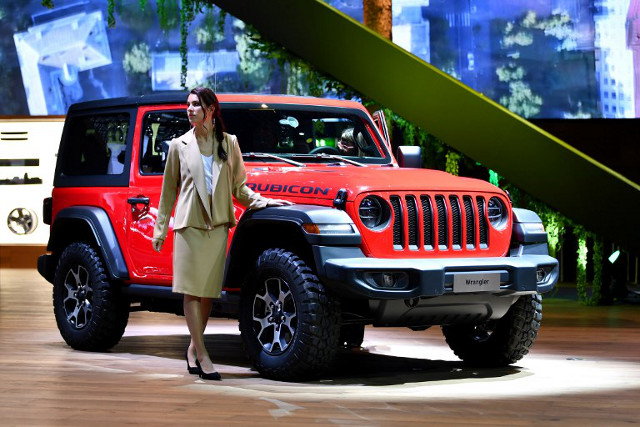
CARS
‘Car explainers’ outnumber ‘booth babes’ at this year’s Geneva Motor Show
Long synonymous with scantily-clad women draped over pricey vehicles, this year's Geneva Motor Show is almost void of 'booth babes', as automakers strive to polish their images following the #MeToo movement.
Published: 9 March 2018 08:55 CET

Photo: Harold Cunningham/AFP
Carmakers have for several years been scaling back the use of skin-flashing models to draw in an overwhelmingly male audience at events like the one in Geneva.
But the trend seems to have gained significant steam in a world reeling from recent revelations of sexual abuse, harassment and discrimination across all industries and growing demands from women for respect and equality.
“I'm very glad because we are not objects,” said Julie, a hostess wearing a knee-length beige dress and heels at one of the stands in Geneva.
“I'm not there to just smile and show my body,” the young woman, who did not wish to give her last name, told AFP.
She was among a new brand of 'car explainers', who this year by far outnumbered the dozen women working as models only on the show's floor.
These young men and women are trained by the companies to provide technical explanations about the vehicles on display, and appear to adhere to a clear dress code: trousers or long skirts topped with long-sleeved shirts and jackets.
“I have noticed that the skirts are a bit longer and that you see less skin than in previous years,” Olivier Wittmann, who heads Renault's Swiss branch, told AFP.

A 'car explainer' at the Geneva Motor Show. Photo: Harold Cunningham/AFP
There continue to be a few outliers, including luxury Italian brand Manifattura Automobili Torino, which has this year again staffed its stand with models in short-short dresses and thigh-high boots.
One of the women towering over a nifty little Manifattura sports car is Italian model Eva Squillari, who told AFP she saw no problem with modelling at the show.
“It's my work, so I always pose for photographers. And I'm not naked so there's nothing wrong with this,” she said.
Squillari, who has been modelling for eight years and is at the Geneva show for the second year running, said she did not believe she or other women were “objectified” at the car show.
“It's a very friendly show so there's a lot of respect for models who are posing here,” she said.
Two young women in short dresses were also posing for pictures at Swiss tire-maker Cooper Tires' stand.
“Trying to make a tire look sexy is a challenge,” one of the managers at the stand, who asked not to be named, told AFP.
“Men like to take pictures of women,” he said, pointing out that “every car that was on TV was with a girl in front.”
“This has always been part of the masculine world of car shows,” he added.
But that view was clearly in the minority at this year's show.
At Renault for instance, Wittmann said the decision had been reached years ago to change its show strategy and focus on competence over sex appeal.
“When we recruit hosts and hostesses for the show, what we are interested in is the (candidate's) capacity to be a good car explainer and to promote our products,” he said.
He said the French automaker had added more men and had basically attained gender parity at its booth.
'Vulgar, unwanted comments'
Toyota's marketing chief Fabio Capano also said his company had “always” focused on training booth workers to explain the merchandise.
“The key point is to be able to explain the product,” he said, adding that there had in any case always been less focus on skin at the European car fairs.
“Europe has always been classy, if you compare to other shows around the world.”
A number of people at the Geneva show voiced support for the shift underway, and also hailed Formula One's recent decision to dispense with so-called grid girls in the lead-up to races.
“Customs change, but I think that is a necessity,” Wittmann said.
The stands of Italian carmakers Fiat and Alfa Romeo meanwhile continued to employ mainly women to showcase their vehicles.
But the women were modestly dressed, and Fiat Chrysler chief Sergio Marchionne told reporters he did not think “we are being offensive to anybody with this”.
While hailing the shifts underway, some of the women on the floor stressed that sexism was still alive and well at car shows like the one in Geneva.
One car explainer, who refused to give her name, said she had received a number of “vulgar and unwanted comments”.
“And sometimes clients ask to speak with a man, since they are apparently more competent…” she said.
Url copied to clipboard!


 Please whitelist us to continue reading.
Please whitelist us to continue reading.